It’s been something of a personal crusade of mine to get more people deep-frying at home (see this post, and this class). Even though I consider French fries the single most important fried food in western cooking, I rarely make them at home. The main reason is that when working with a standard pot it takes several batches to fry enough potatoes to feed my family. While I don’t mind frying half a chicken and putting it in the oven while the second half is fried, the six batches required for fries is a bit tedious. With that said, when I’m feeling ambitious this is how I make fries at home.
What potatoes to use. While you can … Continue reading.
On March 1, 2017 I’m teaching a class for Metro Continuing Education called Deep-Frying Without a Deep-Fryer. Course details are available here. I thought I’d re-post this old article, a vehement defense of this most venerable technique. Originally published March 23, 2014.
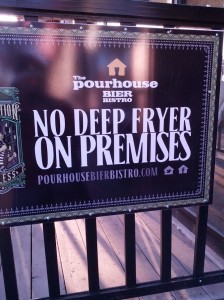 Yesterday I was walking on Whyte Avenue and I saw a sign that upset me. It was outside The Pourhouse, a tavern with a clever name and a broad selection of beer and food. The poster read “No Deep Fryer on Premises.”
Yesterday I was walking on Whyte Avenue and I saw a sign that upset me. It was outside The Pourhouse, a tavern with a clever name and a broad selection of beer and food. The poster read “No Deep Fryer on Premises.”
I perfectly understand the intentions of this advertisement. I have been to bars where the food is clearly manufactured off-site, purchased frozen, plopped into a deep fryer, and garnished with green onions or bottled … Continue reading.
Originally published August 17, 2011.
 If any food can be described as ephemeral, it’s squash blossoms. They’re only around for a short while, and once picked they deteriorate rapidly, which is why you usually can’t get them at grocery stores, only farmers’ markets and neighbourhood gardens.
If any food can be described as ephemeral, it’s squash blossoms. They’re only around for a short while, and once picked they deteriorate rapidly, which is why you usually can’t get them at grocery stores, only farmers’ markets and neighbourhood gardens.
Squash plants actually produce two different types of flowers: male and female. The male flowers grow on the end of long, slender stems. The female flowers grow on thicker stems that buldge where they meet the flower. This bulge is what will eventually become a squash.
Generally there are more male flowers than female. The male flowers can be picked without affecting the production of fruit, so long as a few are left behind … Continue reading.
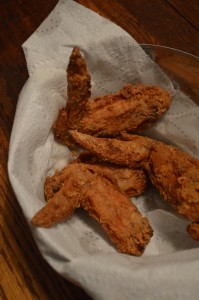 Buying whole animals forces you to eat their various components in rigid proportion.
Buying whole animals forces you to eat their various components in rigid proportion.
For instance, if you go out on a Wednesday and eat two dozen chicken wings, you have eaten the upper appendages of six chickens. If you had to purchase those chickens as whole birds, you would then be stuck with a dozen breasts and a dozen legs that you would need to consume before you ever ate wings again.
All this to say I don’t prepare chicken wings at home very much. But I love them, and sometimes I’ll squirrel away the wings from my chickens, accumulating them over several months, until I have enough to justify preparing them bar-style.
Anatomy of a Chicken Wing. If … Continue reading.
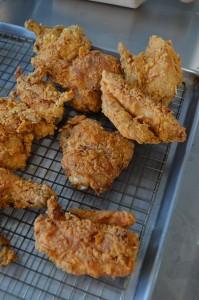 Usually I don’t post about something til I’m confident I have a best practice down pat. I have to say that there’s one important point in my fried chicken technique that I am waffling on: I’m torn between the winning flavour of buttermilk-brined chicken, and the superior texture of dry-rubbed chicken.
Usually I don’t post about something til I’m confident I have a best practice down pat. I have to say that there’s one important point in my fried chicken technique that I am waffling on: I’m torn between the winning flavour of buttermilk-brined chicken, and the superior texture of dry-rubbed chicken.
The Chicken. Frying chicken is a bit of a balancing act: you want the crust to develop the perfect, deep golden brown at the very instant the meat reaches the proper temperature. If you were to take an entire leg from a large chicken and deep fry it, the exterior would get much too dark by the time the meat cooked through.[1]
For this reason I like … Continue reading.
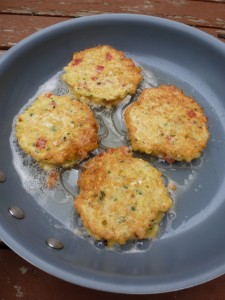 A simple definition. Fritters are made from a simple batter that is garnished with meat or vegetables or fruit and then fried, either in a pan or deep-fryer. They can be sweet or savoury.
A simple definition. Fritters are made from a simple batter that is garnished with meat or vegetables or fruit and then fried, either in a pan or deep-fryer. They can be sweet or savoury.
Why you should care about fritters. Fritters are an important preparation to master for the following reasons: you almost always have the ingredients needed to make them; they fry up quickly; and they are a fantastic way to use leftovers, whether it’s meat like ground beef or ham, or sautéed vegetables, or cheese.
The fritter continuum. The degree to which the batter or the interior garnishes dominate varies widely. Let’s explore the two ends of the Fritter Continuum using corn fritters.
You can make a … Continue reading.
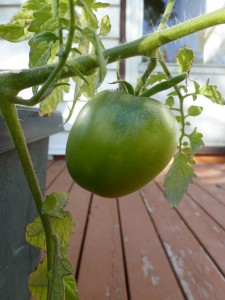 At this time of year we usually have about a dozen unripe tomatoes in their cages in the backyard. Their days outdoors are numbered: this week saw the season’s first frost warning. I could pick the green orbs and let them sit on the kitchen counter. They do ripen, eventually, but this isn’t a very dignified existence for a tomato. Instead, they can be sliced, breaded, and fried.
At this time of year we usually have about a dozen unripe tomatoes in their cages in the backyard. Their days outdoors are numbered: this week saw the season’s first frost warning. I could pick the green orbs and let them sit on the kitchen counter. They do ripen, eventually, but this isn’t a very dignified existence for a tomato. Instead, they can be sliced, breaded, and fried.
Green tomatoes are firm, slightly mealy, and tart. Actually the flesh of the green tomato tastes like cardboard; it’s the jelly that holds the seeds that has all the sour, vegetal flavour. Frying tenderizes them, and breading tempers their acidity. Once they’re cooked the tomato looses its ghost-green colour and takes the … Continue reading.
 Steak fries are big French fries, usually in the form of wedges cut from a whole potato.
Steak fries are big French fries, usually in the form of wedges cut from a whole potato.
As with French fries I use a two-stage cooking method: one low-temperature stage to cook the potato flesh, and one high-temperature stage to crisp them up.
Because steak fries have a more substantial interior than French fries, I think they can handle a much crustier exterior, one that walks the line between crispy and crunchy, with jagged bits of browned potato to contrast the starchy inside.
For reasons explained below I like to use a potato variety that doesn’t hold it’s shape very well during cooking: Russets, which also happen to have a great fluffy, slightly granular texture. Yellow-fleshed varieties hold their shape … Continue reading.
 The doughnut: an important food that for most of my life I have known only in its commercial form. Other examples of such food include hot dogs, ketchup, and potato chips.
The doughnut: an important food that for most of my life I have known only in its commercial form. Other examples of such food include hot dogs, ketchup, and potato chips.
Until recently, every doughnut I had eaten was commercially produced. On top of that, the only freshly-fried doughnuts I had eaten were the mini-donuts at the Calgary Stampede, and a few Krispy Kremes.
As you might expect, the homemade version is vastly superior, especially when consumed within ninety seconds of being removed from the oil.
What would a Button Soup post be without some mention of spelling or etymology? For the longest time I assumed these pastries were originally called “doughnaughts,” as in naughts (zeroes) made out of dough, … Continue reading.
The personal website of Edmonton chef Allan Suddaby
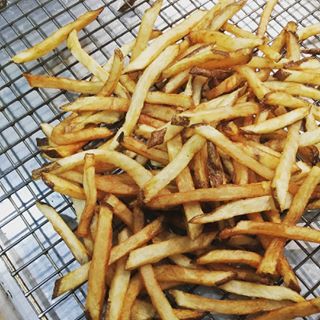




 A simple definition. Fritters are made from a simple batter that is garnished with meat or vegetables or fruit and then fried, either in a pan or deep-fryer. They can be sweet or savoury.
A simple definition. Fritters are made from a simple batter that is garnished with meat or vegetables or fruit and then fried, either in a pan or deep-fryer. They can be sweet or savoury.

